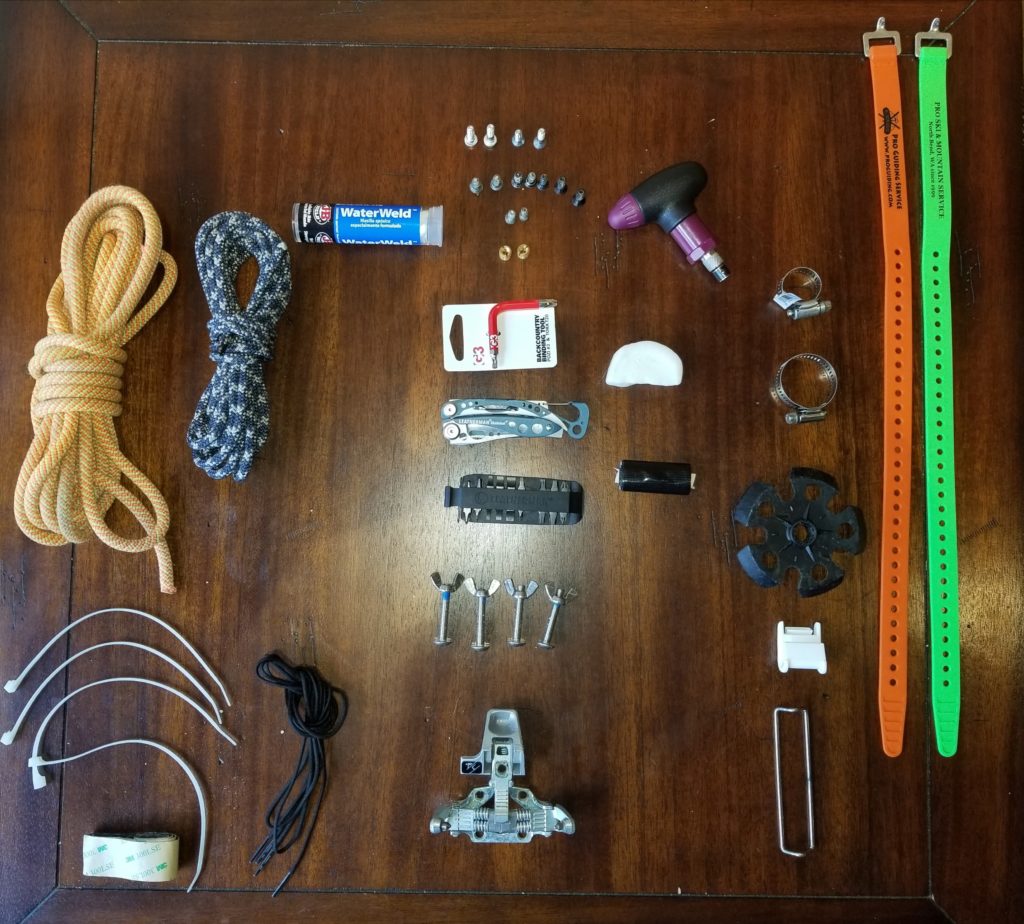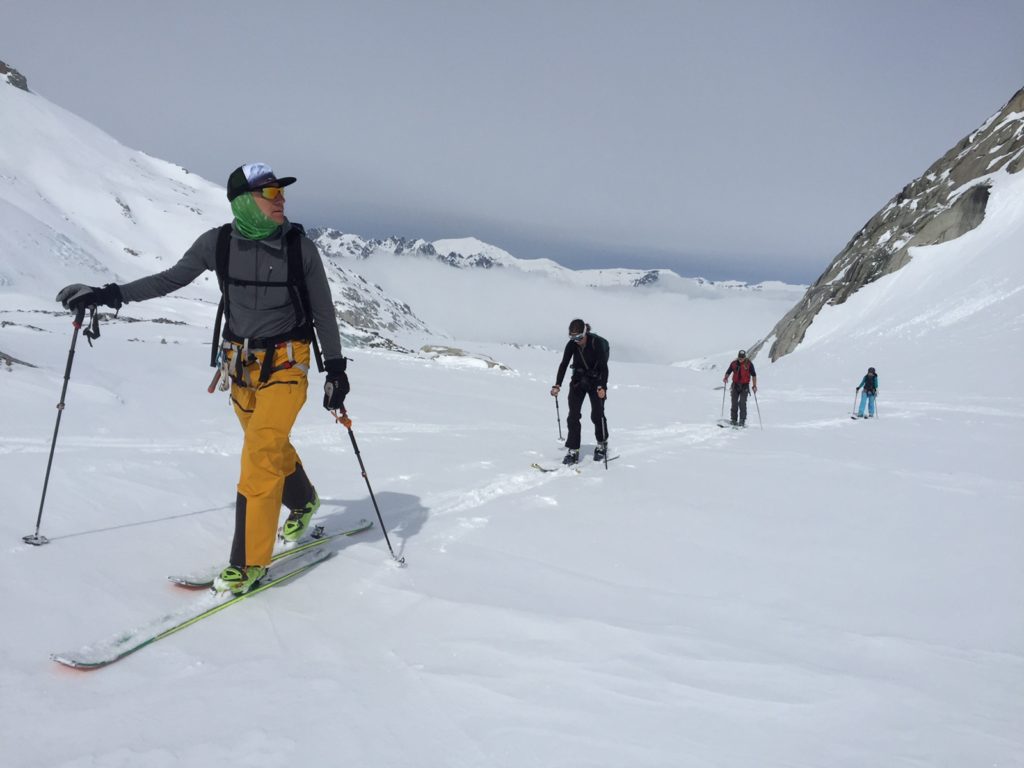How To Build a Backcountry Repair Kit
What scares me most in the backcountry is not an unexpected event over which I have no control. It’s experiencing a problem that could be solved with a simple solution—one I hadn’t thought of or prepared for yet.
Being unprepared might lead to a night spent outside, frost nipped toes, or even worse. But worst of all, being nothing more than a bipedal husk of neuroses and vanity, would be the self-destructive loop my mind would lapse into: “You idiot! This was so easily avoidable!”
The Repair Kit
A thoughtful, versatile repair kit customized for your activity and environment can head off such unwelcome situations. And it’s cheaper than therapy to repair my fragile male ego.
Most experienced practitioners—whether they’re mountain bikers, climbers, skiers, or hunters—adapt their kit to their particular mission and objective. A ski tour within sight of the road or with a dozen friends at a hut demands a different kit than say, a Rogers-to-Bugaboos traverse in the Selkirks.
Swiss Precision
I reached out to Martin Volken, owner of Pro Guiding Service and Pro Ski and Mountain Service in North Bend, Wash., to glean (read: steal) his tips on what to carry in a repair kit. Volken grew up in the valley below Zermatt, Switzerland, in a village called Stalden. He studied to be a mountain guide in Switzerland before moving to North Bend. He is also the author of the definitive guidebook for skiing in the Cascades.
Here’s what he recommends as a baseline kit for a day tour. If you are doing a multi-day traverse, relying on a stove, or have no chance of SAR assistance, you might augment this. Read on, claim as your own, and bask in the deep-seated confidence a repair kit can bring.

— Lengths of cord in different diameters. With three 5-meter lengths of half-inch webbing and one 3-meter length of 3-millimeter cord, you can rig a rescue sled, wrap a ski for improvised traction, make a leg splint, set up a tarp for winter shelter, or make a strap for tree-well or creek exit.
—Zip ties. Close a blown zipper, improvise a skin tip, repair a pack strap. Be sure to buy only the strength-rated, cold-resistant ones at a big hardware store like Home Depot or online.
—Self-adhesive nylon patch repair tape like Tenacious Tape. Fix a punctured puffy or sleeping bag, or keep a hole in your backpack from opening further.
—One meter of 2-millimeter thick cord to repair a pack strap or other critical piece of gear. (A shoelace works in a pinch.)
—Standard binding screws (or ones specific to your and your team’s bindings) in differing lengths with beveled and flat heads
—A couple of Helicoil inserts and steel wool for torn out screw holes. Reseat/reaffix a binding for an almost good-as-new repair.
—Epoxy/cement for gluing in torn-out screws in a wet environment. Be sure to get one that dries quickly, as almost all two-part epoxies will not cure in the field.
—Some binding adjustment options: A basic G3 Torx and Phillips head tool; a Leatherman Skeletool with various tool attachments, or a Binding Buddy (heavy). A driver extension helps work in confined/awkward spots, as with certain bindings, etc.
—Longer screw bolts with wing nuts for varying uses, including assemblage of a K2 Rescue Sled using shovel handles attached to the tips and tails of skis. Self-drilling screws are hard-tipped and eliminate the need for a drill, should you need to redrill skis or a boot shell.
—Paraffin wax works well on skis, skins in the spring, and as an emergency fire starter.
—Cold-rated duct tape
—Hose clamps for pole repair
—Extra pole basket. Don’t discount how important this is, especially on a tour with long, flat sections.
—Skin tail clip
—Skin tip loop
—Voile straps. Use it to strap your boot to the ski in a pinch, close a ski boot in lieu of a buckle, lash skis to a pack, and so on. Use four of them around your ski’s base as an improvised “skin.”
—Butane lighter with a good flame or storm-proof match kit and fire starter (see paraffin wax)
—Ski scraper for snow and ice build-up (not pictured)
—Headlamp and batteries (not pictured). Not only will this help you see your gear in order to fix it, but also it can aid in signaling the helicopter or rescue team.

Customize
Volken’s kit will fix a million different mishaps, but you should still take the time to customize it for you. For example, some people forego the BD “Binding Buddy” for a slightly lighter tool like Topeak’s Ratchet Rocket ($30, carry relevant bits) or Fix It Sticks Blend ($34).
Whatever bit driver you choose, do your homework. If you’re rocking anything out of the ordinary, make sure you have the bits to tighten screws and bolts specific to the gear. Double-check you have extra bolts and screws, too, in case they loosen and disappear during your on-snow heroics.
If you’re guiding or touring with less-experienced buddies, consider their gear, too—split boards have different bits than ski stuff, and Euros will sometimes have slightly different gear than North American gringos.
Consider the kind of adventuring you’re doing, too. Going to Morocco to ski the High Atlas? Chances are you’re not going to ski down to town and be able to find a replacement part as you would on a Haute Route, therefore packing both a binding heel and toe seems smart. Doing a boat-based ski-and-sail mission on Svalbard? Bring a set of spare skis. Vallée Blanche on a warm, sunny day? Meh, you probably won’t need much.
Common Carnage
“I differentiate between gear failures and catastrophic gear failures,” says Volken. “For the most part, broken poles, broken buckles, walk mechanism on boots—all that stuff is bad, but it’s not terrible if you know how to ski. I did an entire Haute Route without a heel piece. If you know how to ski, you just keep skiing. If you break a toe piece, though, that’s pretty bad.”
Poles break more than almost any other piece of kit, so have a couple tricks up your sleeve. I snapped a pole setting track up to Loft Peak outside Smithers, B.C., one year. My colleague rolled up and swapped his with mine. At our next break, he reappeared with my pole repaired: two short sections of pine branch, wrapped firmly with duct tape. It worked all week!
Another easy fix for poles is a few wraps of sheet aluminum from a can of soda or beer. Next time you crack open a Grape Fanta, cut out the ends and you’ve got a great pole splint. Wrap the broken section, affix either end with a plumber’s clamp from Volken’s kit, and you’re in business. Works for tent poles, too.
Bindings can actually be a relatively easy fix, if you’re prepared. The plumber’s cement fills a blown-out hole. You can insert a Helicoil and set it with the cement, or screw directly into a hole plugged with the stuff. In a perfect world, see if you can experiment with it first to get a sense of how it works and what you can get away with. (Be careful using Gorilla Glue, as it expands quite a bit as it dries and can actually end up pushing the binding plate up and off the ski.)
If you can’t get the new screws to hold or the holes are too far gone to repair, you can also drill completely through the ski and out the base. You’ll either need a drill bit for this, a small knife blade or awl on a multi-tool, or self-drilling screws. Insert a screw from the base (use a washer here if you have it), all the way through and out the top of the ski. Ideally the bolt has a rounded or flat head. Bolt your binding on as best you can.
This might work for a completely broken ski, too, by overlapping the two parts and drilling through the whole shebang. (If you try either of these potential fixes, good luck, and please do not go to your local gear shop once you return to civilization and demand to warranty the ski.)
In Volken’s kit, he has specific nuts and bolts to incorporate a shovel handle into a rescue sled. To accomplish this, he would need an extendable-handle shovel. Each section of the handle would have holes drilled at its ends. His skis, too, would have holes drilled at the tip and the tail. If he needed to build his sled, he could bolt one shovel handle between his ski tips and the other between the tails. Long bolts with wing nuts would do the trick.
Once he’s bolted the skis into a long rectangle, using ski straps and poles, he could cross-brace from tips to heel pieces, fashioning his poles into an “X” to give the sled rigidity. Lay a tarp on top of this, pad it, and package your patient.
In a serious pickle, you could drill the tips and tails and improvise this fix. (K2 and Völkl backcountry skis come drilled for this purpose). Remember, though, the moment you drill into your skis, you void the warranty.
Boots occasionally break, and thankfully it’s usually pretty workable if you have the parts. Bringing a replacement buckle and, for a long hut-trip or an extended traverse, spare hardware for the “walk mode” might be a good idea. Eyeball your particular boot and guesstimate if you could repair a failure with improvised materials or if you need to carry replacement parts. If you do choose to carry replacement buckles, etc., make sure you have the rivets or bolts to attach them to the boots.
MacGyver
Whatever you come up against, channel your inner MacGyver, combine all the gear in your team’s repair kit(s), and get creative. Usually repairs make for a funny story down the road, but if you lose the ability to travel in deep snow (skin failure, binding, etc.), you’re looking at a potentially desperate emergency. Do your best, get creative, adapt, and try to fix the problem.
In the event your repair kit can’t do the job and you’re facing a real problem, hopefully your team has a communication strategy and expert winter survival skills. Stay warm and dry, use your tarp for shelter, and call for help with a satellite communication device.
Rob Coppolillo lives and writes in Chamonix, France. He’s an internationally licensed mountain guide and the author of The Ski Guide Manual ($32.95; Falcon Guides).


